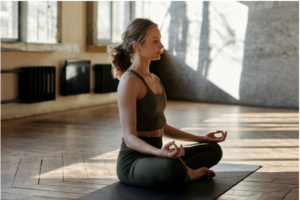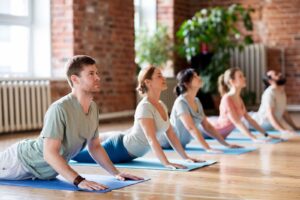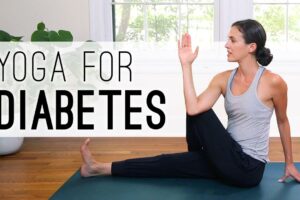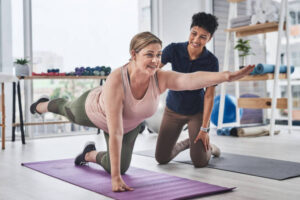You do not necessarily have to join the gym for strengthening your core. It’s a common perception among people who do not practice yoga regularly that it is a slow & meditative activity that involves fluid movements and works on your body’s flexibility. But that’s not all about yoga. It’s one of the best activities you can perform for improving strength, toning your body & boosting your health. Yoga is an amazing tool for improving your core stability and strength. Strengthening core helps in relieving back pain, improving posture, and promoting a healthier & happier spine overall. And it’s no secret that strong-deep abdominal muscles are also the key to boosting your athletic performance and easing everyday activities. In this article, we will describe yoga postures that you perform for stimulating the energy, strength, and growth in your core and back.
Safety & Precautions
Paying attention to the flow of movements & poses or the yoga for core and back stability that you are core in is highly important. The rhythm of movement eases the sequence, which promotes the health of both the spine & abs. Performing three to four poses in particular helps with jazzing up the workout routine. And also keep you better aware of your movement as you move carefully in and out.
After getting your workout clothes we would suggest you pick a couple of poses from below that target your abs & pair them with moves that work on your back, & then perform them together in the sequence for keeping the body balanced & healthy. The poses described below are safe for everyone, but if you’re pregnant, suffering from back pain, injured, make sure you get a clearance from your doctor before trying those poses.
Another misconception is props & modifications should be done unless necessary. People think that aiding their poses makes them weak or is some kind of cheating. Modifications, like dropping to the knees for planks, using bolsters & blocks for elevating and supporting certain body parts, are healthy techniques that should be incorporated where needed. They promote the safe, ergonomic, and comfortable execution of poses.
It’s a common misconception among people that if the new workout regime core does not hurt, then you are not doing it correctly. During yoga practice, if a move or pose hurts during the flow, be mindful of the level of pain & either reset or take a break until the alignment is strong enough for supporting that pose. You should not experience pain during your sequence. You will experience tightness or contracting in your abs but the pain is never a measure of how successful your practice is.
1) Cat-Cow Stretch
Begin this pose by bending and going down onto all of your fours, place your knees under the hips & the wrists under the shoulders. It is one of the best yoga for core and back stability. Perform a few Cat-Cow Stretches for warming your body up, by arching the back on the inhalations & rounding the spine on the exhalations. Make sure you keep the belly hugging throughout the motions.
It’s an amazing way of warming up your abdominals as this movement targets your rectus abdominis & external obliques. Also, you can pull in your abdomen towards your spine at the back while you inhale & relax it as you exhale.
2) Hands & Knees Balance
Hand and knee balance work amazingly well for strengthening and stabilizing your obliques & your transversus abdominis. Keep your focus on compacting your abbs towards the center for creating the corset effect. Start this workout by keeping your hands & knees in a neutral position with your spine.
Then lift the right leg & straighten it, hold it in a parallel manner with the ground and flex the right foot strongly. After you have stabilized yourself, raising the opposite arm, parallel to the ground. Hold the position for five breaths. Then repeat it by switching your arms and legs.
For adding challenge to this position, bend your right knee & reach around the back by using your left arm for holding the right ankle.
3) Boat Pose
It’s a standard yoga pose that helps in developing building core strength. It’s a stationary pose that also improves stability & mobility. After getting in your workout clothes begin this yoga pose by seating on the legs extended at your front. Sit tightly tall for lengthening the spine, after that start leaning your back slowly while bending both of the knees. Another important yoga for core and back stability.
Keep on leaning back till you can lift the feet from the ground. Then flex the feet for activating the legs. If it is too hard, hold the bent knees by using both of the hands for maintaining the lengthening of the spine. Boat Pose is the V-shape posture, practiced with the legs & arms in a fully extended manner. Hold the pose for a few moments and take deep breaths. Breathing rhythm is the key to most yoga postures. Inhale for maintaining your back length.
Feel your breath deeply rising to fill up your lungs. While you exhale, engage your abdominal muscles by pulling your abdominal muscles. It’s called Abdominal Lock in yoga. It helps in maintaining posture. Hold this position for 10-20 breaths then take a break.
4) Bridge Pose
This pose solely focuses on your abdominal muscles and strengthens the core. It concentrates on the back, too. It promotes the body’s flexibility which boosts your performance for various athletic activities. Start this pose by lying straight on the back with both of your knees bent, and feet flat on the ground.
Align the knees so they come directly over the ankles and heels while giving you good leverage. While exhaling, press both of the feet firmly on the ground for lifting the hips off the floor. Then bend both of your arms at an angle of 90 degrees for pressing the back of the arms down on the floor for further lifting the upper body.
You will make a mild yoga backbend that will open your front side of the body. As you take deep breaths in & out, sustain your position. Hold it for strengthening the muscles of your back, particularly your erector muscles. Bridge Pose also targets the low back region if you are experiencing any pain it will relieve it. Hold your posture up to 10-20 breaths.
5) Modified Triangle Pose with Lifted ArmsThis yoga pose helps a lot in relieving back pain & tension in your arms and shoulders. It’s a simple modification for extending the arms at your front as if you are grasping a ball that targets the abs, while you keep the body stable, lifted & balanced.
Start this pose by standing lengthwise on the mat with the feet palace parallel & about three feet apart. Then turn the right foot out at the angle of 90 degrees, so the toes face a short end of the mat, while the left toe turns about 5 to 10 degrees inward. Then Inhale & lift the arms in a line with the shoulders by using the palms while they face the ground.
Exhale deeply, stretch forward, while lengthening the left side of the body as you reach the foot with the right fingertips. Then stretch your left hand while the left palm is facing forwards & gazing towards the middle finger of the left hand. Stay in that position for a whole breath before you engage the core, reach both of the arms at the front of the room, as if you are holding the exercise ball. Stay in that position for six deep breaths before you repeat it on the other side.
6) Down Dog SplitsThis pose works very well in stabilizing your body and core muscles. As you balance it engages your external obliques along with the transversus abdominis, in the deepest of your abdominal muscles. Keep your focus on hugging your ribs back & in to avoid the bend in your back.
Bend down on your all fours. Then curl the toes under while drawing the hips back as they begin to straighten the legs while Downward Facing Dog. Keep the belly pulled in towards the back of the spine.
Take a deep breath and raise the right leg till it roughly becomes parallel to the ground while going on the Down Dog Split. You can lift your leg higher if you want while keeping the hips squared towards the ground. Hold this position for 5 deep breaths and repeat by switching the leg.








